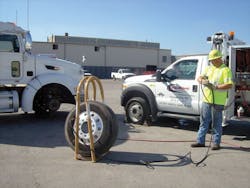There are no tire busters at Cross-Midwest Tire Co. Instead, the Kansas City, Kan.-based commercial tire dealer employs tire technicians certified to the safety standards developed by the Tire Industry Association (TIA).
Neal Seyfert has built the Cross-Midwest safety program around the distinction between tire changer and tire technician. His position as director of operations includes responsibility for the safety training and performance of Cross-Midwest employees. The company relies on programs like those developed by TIA, whose training goes beyond the requirements of the Occupational Health and Safety Administration (OSHA).
“As a company, we’ve realized there’s a lot more to this industry than the OSHA-required training. We’ve recognized the importance of advanced training through the TIA program,” says Seyfert. He credits TIA’s training with creating a safety-first culture at Cross-Midwest. “Our safety-first culture has been created from the top down, and is a complete team effort designed for the safety of us all.”
Cross-Midwest is No. 12 on the Modern Tire Dealer list of top commercial tire dealers. The company operates 14 commercial locations in Kansas, Missouri and Illinois and has approximately 100 drivers. It is No. 82 on the MTD 100 list of the nation’s top independent dealers.
“The TIA training has helped change the culture of our safety program. We have some guys who are 15-year veterans. They know the right way to change a tire, but they may not have known the safest way. TIA training is not only about learning how to change a tire, but also how to look for potential harmful situations when changing tires.”
Safer workers also bring bottom-line benefits to commercial tire dealers, according to Chris Hoogenboom, director of training for TIA. “Look at training as an investment that improves customer satisfaction, lengthens tire life, reduces insurance premiums, reduces employee turnover, improves quality control and increases employee morale.”
[PAGEBREAK]
Start with the basics
Recognizing hazards is the basis of TIA’s training program. “Tire service can be so dangerous to techs and the motoring public,” says Hoogenboom. “Proper training is essential. TIA built these programs with one thing in mind: Everyone deserves to go home safely at the end of each work day. We do everything we can to make sure that happens.”
The organization began offering the training in 1997 because commercial tire dealers wanted more than a video and a workbook, according to Hoogenboom. “They wanted instructors in front of students so there could be discussion, questions and, most importantly, answers.” The first level of TIA training is called Basic Commercial Tire Service Training and Certificate Program 200. The 200 level meets the minimum federal training requirements mandated by OSHA for both new hires and experienced employees in need of documented training.
The 200-level training is approximately four hours in length, and the lessons are delivered online or via a workbook or DVD. The TIA Online University was created in April 2012 to make the 200-level training available to technicians through an Internet connection. Cross-Midwest was the first company to enroll its employees, who are required to complete the training online when hired.
Next step is to certify
After reaching one year of experience, a technician participates in a 300-level training seminar conducted by a TIA-certified instructor to prepare for the TIA certification exam. A technician who successfully completes the certification training and final exam receives a certificate and uniform patch.
Dealers who wish to train and certify their employees to TIA’s standards have two options. The first is to find a TIA-certified instructor in their area and arrange for training directly with the individual. The second is to send an employee through an instructor training class offered by TIA. Upon completion of the training, he or she can return to train and certify the remaining employees. Cross-Midwest chose the second route, and Seyfert became a certified instructor in September 2012.
People who attend instructor training are surprised to discover what they don’t know about safety, says Hoogenboom. “They think they are doing everything right but find out there is so much more to safety than what they thought.”
Hoogenboom and Seyfert attended the same instructor certification class in Baltimore, Md. She says Seyfert shared his ideas for improving the safety program at Cross-Midwest. “We discussed what he would change, and the first thing he did was implement the industry-recommended torque program. I knew then he was serious about changing the safety culture because a torque program is expensive.”
[PAGEBREAK]
New safety policies
The torque program at Cross-Midwest involves equipping all service trucks and shops with torque wrenches and having the wrenches calibrated by an outside vendor on a regular basis. In addition, technicians are required to torque every wheel.
“Every one of our service trucks and shops has torque wrenches,” says Seyfert. “Our policy is to ensure every lug nut is torqued, and then verified by a second employee.” The torque process at Cross-Midwest is the standard procedure taught in the TIA program.
“We’ve been able to implement several other safety policies with the help of TIA,” says Seyfert. Some of those policies include the use of safety glasses, jack stands and safety cages. Cross-Midwest also requires the use of whip hoses during the inflation process so the technician can stay out of the trajectory zone.
The company adopted neon yellow, the recognized color for designating caution, as an employee uniform to protect workers from being hit by other vehicles when working on the roadside or in a parking lot.
“We decided to choose the safety yellow color because the safety orange color looked too much like an orange construction barrel on the side of the road,” says Seyfert. For added safety, reflective strips are on the shirts of employees working outside the shop. “We look at uniform shirts no differently than hard hats and safety glasses.”
Although dealers can contract with third parties to provide safety training to their employees, there are no private companies offering training tailored for tire service workers, according to Hoogenboom. “Other than a few companies that have developed programs internally, not a single organization offers a complete OSHA-compliant training package for commercial tire service other than TIA. There are bits and pieces out there, but we’ve put it all together in one program.”
Seyfert says being safe does lead to a better work environment and improves the ability of a company to meet customer commitments. The company’s promise to customers is posted on its website: “Rain or shine, snow or sweltering heat, day or night — the Cross-Midwest team is always ready to keep a fleet of one to one thousand — or more — running 24/7.”
Keeping a promise to be there wherever and whenever required starts with an effective safety program. But Cross-Midwest sees beyond the business side of safety, says Seyfert.
“We know we’ve given our employees the tools to understand how to do the job safely. We require the use of these programs for the safety of our employees, and believe they should all go home with exactly the same abilities they came to work with.”
Hoogenboom says TIA training helps improve employee morale and retention: “When a company requires TIA training, employees see their company is taking the time and money to invest in their education and safety. We’re raising the level of professionalism. They are certified technicians. That means a whole lot more than tire buster.” ■




